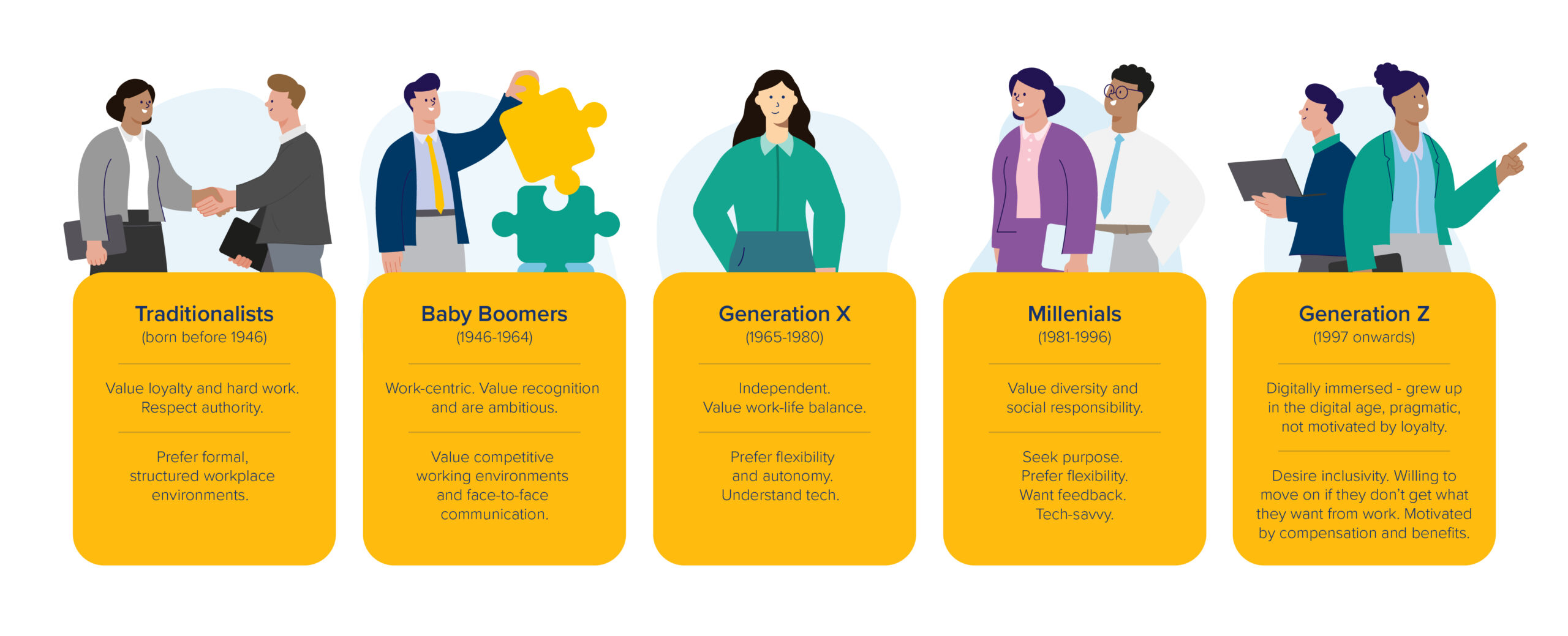This creates a complex workplace dynamic full of both challenges and opportunities. By identifying them, you can explore targeted strategies to not only mitigate generational clashes but also to capitalise on the strengths that each age group offers. A well-managed multi-generational workforce can be a formidable asset to any business.
Your starting point must be to understand your own workplace’s demographic. Undertake an audit – who have you got and how many of each do you have? Each and every workplace will have its own particular multi-generational dynamic. A tailored approach is needed.
- Tackling communication across the ‘generation gap’
In multi-generational workplaces, different communication preferences can impact team dynamics. Traditionalists and Baby Boomers, having spent much of their careers before the digital revolution, often prefer direct, face-to-face interactions or detailed emails. On the other hand, Gen Xers tend to lean towards quick, direct communication mediums like emails and phone calls but are also comfortable with emerging technologies. Millennials and Gen Z, raised in the digital era, favour instant messaging and social media platforms for rapid and informal interactions.
These differing preferences can lead to misunderstandings and conflicts, as messages may be interpreted differently across generations. For instance, a brief instant message from a Gen Z employee might be perceived as curt or disrespectful by a Baby Boomer who values more formal communication.
To bridge these gaps, you could implement diverse communication tools that cater to the varied preferences across the workforce. This could include a mix of traditional and digital communication platforms such as email, corporate social networks, instant messaging apps, and video conferencing. Allowing employees to choose their preferred medium could increase efficiency and reduce misunderstandings.
Training in communication effectiveness is crucial and should focus on enhancing understanding among generations about different communication styles and the potential for misinterpretations. Workshops can be useful in demonstrating the impact of tone, medium, and style suited to each generation, while role-playing scenarios and group discussions can help illustrate effective communication strategies and encourage empathy and respect for each individual’s preferred style.
- Banter and the ‘generation gap’
Banter in the workplace is a double-edged sword: it can play an important part in lifting the mood and helping the working day pass quickly; it can also all too easily stray into bullying and harassment.
Each employee is, to an extent, a product of their generation. Employees may have difficulty understanding that the way in which they have interacted with others throughout their lives is no longer appropriate at work. It’s perhaps important to remember that it’s not so very long ago that discriminatory workplace behaviour was entirely ‘unpoliced’. There were no laws prohibiting it in any form. You will employ people who entered working life during this time.
So, it’s no surprise that generations have different views on ‘banter’ – what might seem like a harmless ‘joke’ to someone from Generation X could quite easily have Generation Z up in arms.
How do you deal with this? Have a clear anti-harassment and bullying policy and train on it. Explain to all employees what is acceptable and what is not. Workplace standards, not ‘generational standards’, are what apply at work.
Train managers to lead by example – workplace culture is, more often than not, a ‘top-down’ affair. You only have to look at high profile recent examples like the CBI and Red Arrows to know that. Take action if employees act inappropriately. If you allow standards to slip you could be seen to be validating inappropriate behaviour.
- Using technology
You likely employ some people whose first encounter with a computer was in an episode of ‘Tomorrow’s World’. You will also employ others who don’t know a world without home internet and mobile phones. It is important that your whole workforce is comfortable working with modern technology and that no-one feels out of their depth.
As ever, don’t make assumptions. Offer tailored tech training to all – not just those of a certain age or seniority. Start with the basics – and keep that basic training continually accessible – employees might not want to speak up to ask ‘basic’ questions more than once but, if the training is always available, they will not feel uncomfortable.
Consider reverse-mentoring specifically focused on the use of technology. Invite volunteers from across the workforce and pair younger tech-savvy employees with older employees. Encourage them to collaborate and share their knowledge of technology. Have feedback tools in place so you can check if the business is reaping benefits from the initiative.
- Different work ethics and values
One of the key characteristics of each generation is their attitude to work and the workplace. As a general rule, Baby Boomers and older members of the workforce value face-to-face communication and place an emphasis on working hard to contribute to the business. By contrast, Millenials and Gen Zers are far more focused on ‘what work can do for them’. The employer-employee relationship is far more even-handed when viewed through their eyes. They want recognition and they want flexibility.
No viewpoint should be ignored. They should all be understood and respected. If HR can get to a position of understanding where each generation is coming from they can work towards moulding a workplace which has the flexibility to ‘work’ for all. How?
Ask your employees what they value and what they want from their job – surveys and workshops are a good way to do this. And then take action, whether that be through creating a flexible benefits structure, promoting the possibility of flexible working and educating those who may see this as an alien concept on the benefit or using inter-generational workshops to break down barriers and promote respect and understanding.
If your workforce feels ‘heard’ and that their viewpoint is valued, your business will be a better place for it.
Appraisals are often a generational pinch-point where work ethics and values come to the surface. Appraisal processes are generally hierarchical – with the more senior (generally older) manager appraising the less senior (generally younger) employee. There is a risk that the appraiser will judge the appraisee through the lens of their own work ethic and values. This is a trap which should be avoided. HR have a role here in creating a dynamic appraisal process which steers away from the judgment of any one individual.
Consider utilising 360 degree appraisal tools so that individuals are appraised by peers and subordinates as well as management, offering unconscious bias training for those conducting appraisals and using objective evaluation criteria in the process where possible.
- Avoid making assumptions
Although it can be helpful to take a broad-brush approach to gain an understanding of the people working for you, it is important to avoid making assumptions. It would be wrong to assume someone is work-shy and has a sense of entitlement just because they fall into Gen Z. Generalisations like this can, in themselves, amount to age discrimination. In Glen Cowie v Vesuvius the Claimant was successful in his age discrimination claim after he was referred to as an ‘old fossil’ who ‘did not know how to manage millennials’.









